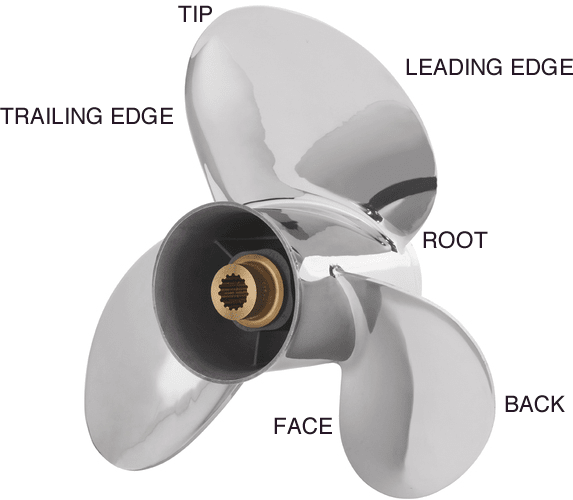Does your boat take a long time to get up on plane? Maybe not hitting the top speed you think you should? Are you looking for better all-around performance and fuel economy? Apart from keeping your boat’s hull clean and your engine(s) tuned, selecting the right propeller is one of the easiest actions you can take to get the most out of your boat.
First of all, note that the primary criterion for selecting a propeller is to make sure it allows the engine to “turn up” to a speed within the range specified by the engine manufacturer — usually within 500 revolutions of absolute top rpm. This ensures a long life for the engine, neither lugging it down nor letting it over-rev. Your engine probably came with a propeller that achieved that basic requirement, but you can select a variety of props that will allow the engine to turn up yet have differences in pitch and number of blades, plus possess more subtle characteristics. For example:
Propeller Size
Expressed with two numbers, diameter and pitch, with diameter always stated first. Diameter is two times the distance from the center of the hub to the tip of any blade. Smaller prop diameters generally go with smaller engines, or with fast high performing boats. Pitch is the theoretical forward distance, in inches, that a propeller travels during one revolution. Think of pitch as speed, or as the gear selection on a car’s transmission.
Pitch
Over revving or under revving can be corrected by selecting a prop with a different pitch. Engine rpms and pitch are inversely related. Increasing the pitch will decrease engine rpms and decreasing the pitch will increase engine rpms. As a general rule, if your engine is under revving, consider a propeller with less pitch. If your engine is over revving, consider a propeller with more pitch.
Material
Aluminum is the most common, least expensive material. Suitable for most outboard and sterndrive applications.
Stainless steel offers a performance advantage over aluminum due to stiffer, thinner blades and more advanced designs. Best choice at speeds over 50mph, or if your boat is running over oyster beds or sandbars regularly. Stainless costs more but is five times more durable than aluminum. Stainless props can be repaired, at a higher cost, to like-new condition, while repaired aluminum will suffer from metal fatigue and a loss of strength.
Three or Four Blades
Three-blade designs give you all-around performance with an advantage on top end speed. Four-blade designs work well with boats that are difficult to get on plane, underpowered or used in watersports where top-end speed is not critical.
In many cases boat builders work with engine manufacturers to spec out the optimum propeller for the engine and boat that they’re selling. If you’re looking to replace a damaged prop or increase performance, a call to the builder of your boat may be a good place to start. Or talk with the service manager at a local boatyard. These conversations could save you the expense and time of a trial and error search for the right propeller.
